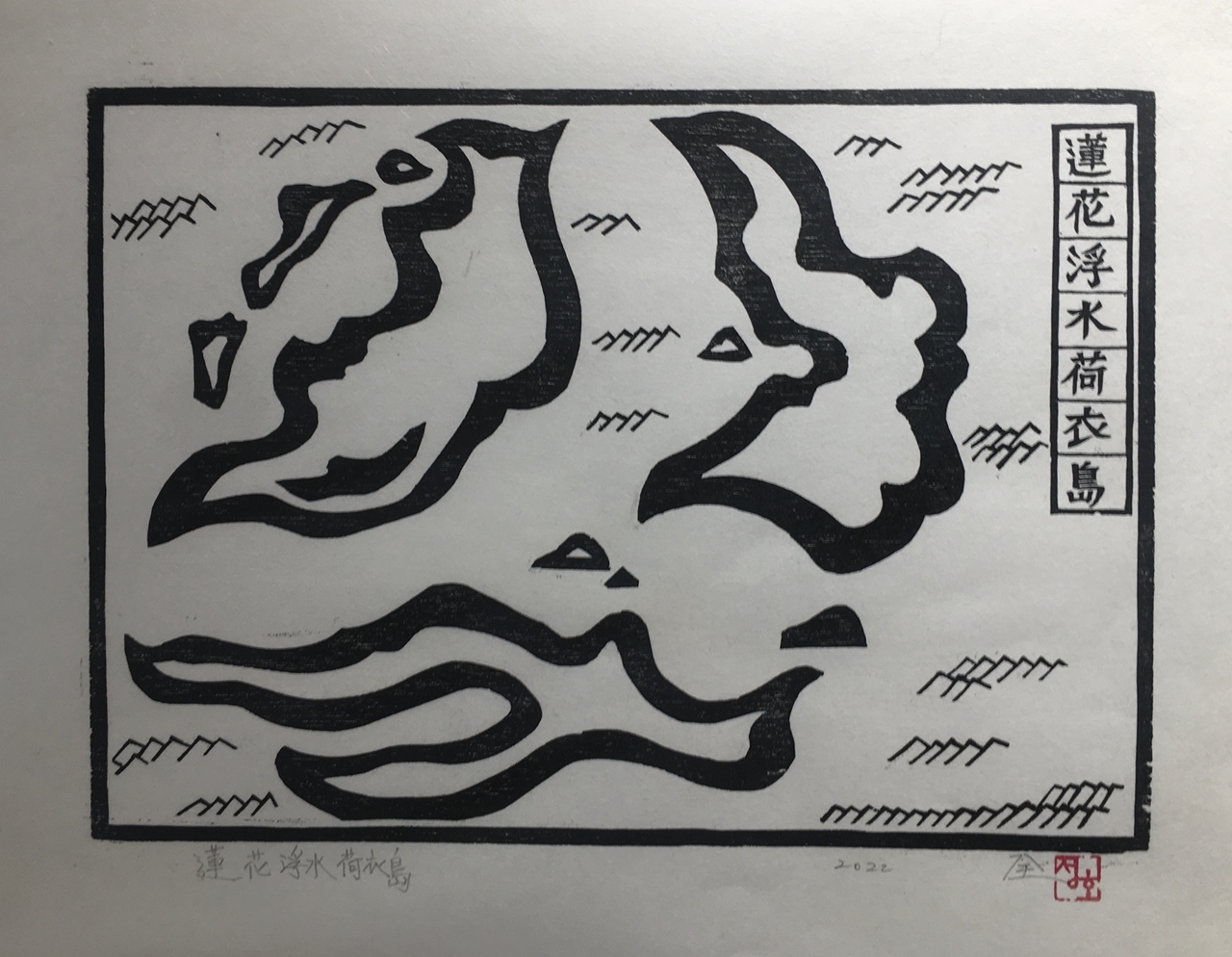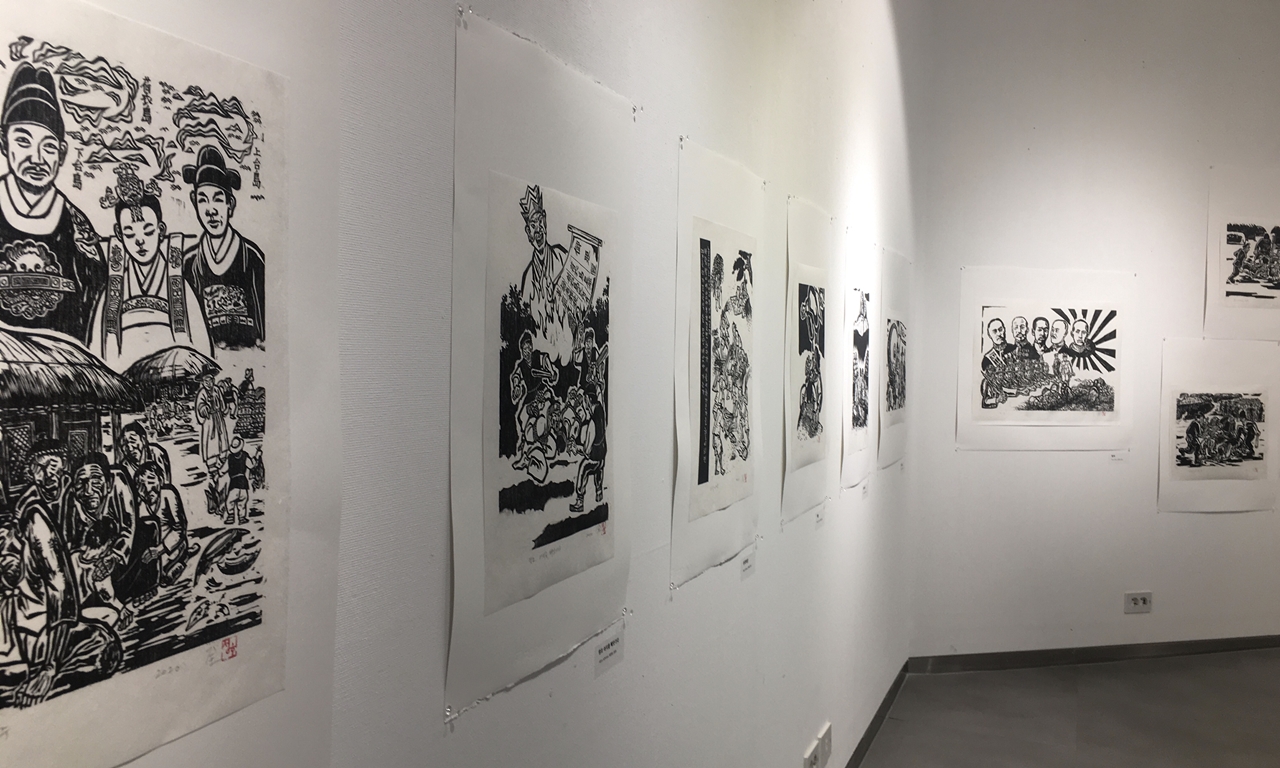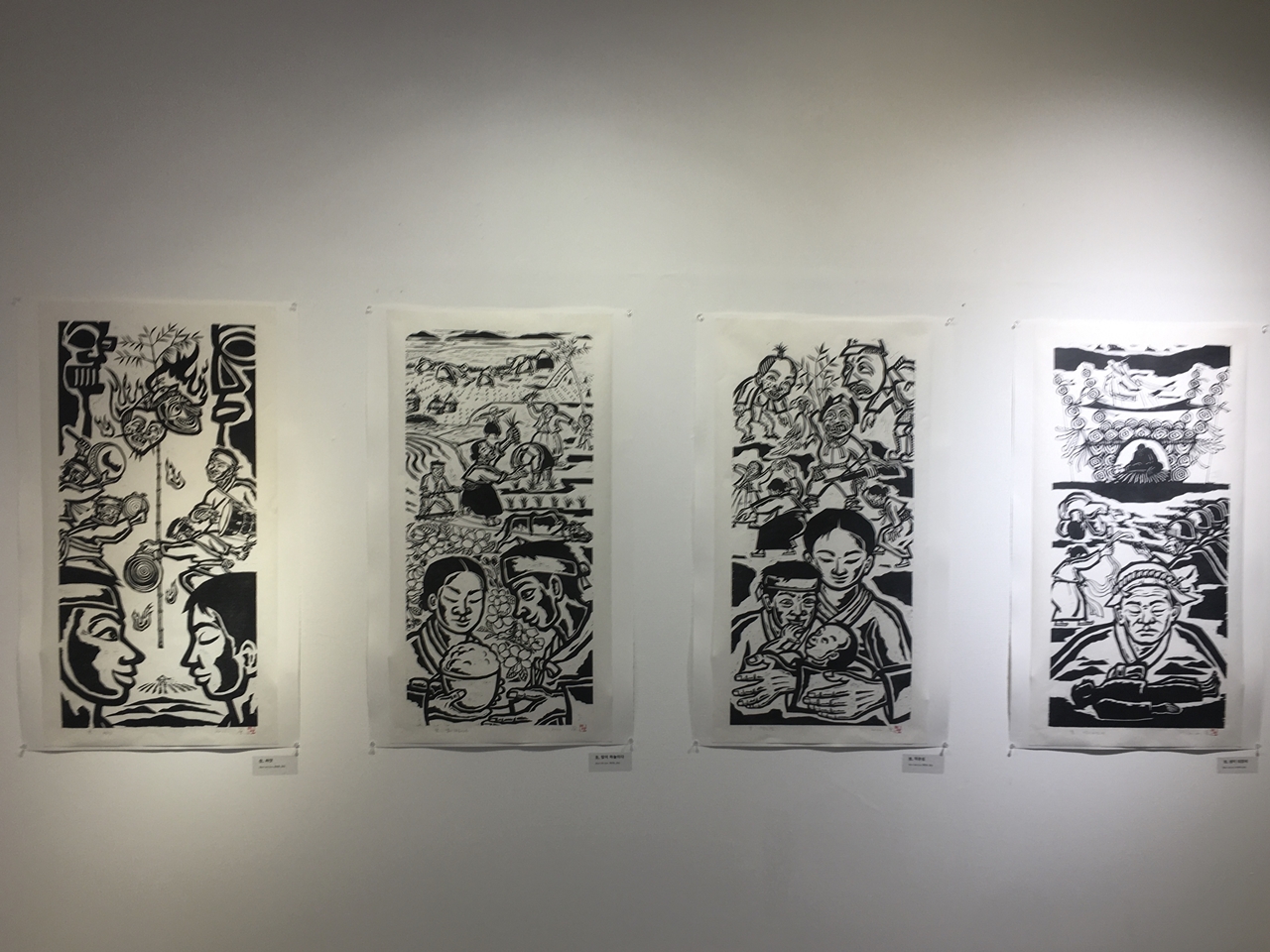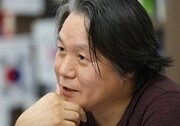[평화예술칼럼 Peace Art Column] (87) 김준기
| 제주도는 평화의 섬입니다. 항쟁과 학살의 역사를 가지고 있기에 평화를 염원하는 마음은 더욱 간절할 수 밖에 없습니다. 제주4.3이 그렇듯이 비극적 전쟁을 겪은 오키나와, 2.28 이래 40년간 독재체제를 겪어온 타이완도, 우산혁명으로 알려진 홍콩도 예술을 통해 평화를 갈구하는 ‘평화예술’이 역사와 함께 현실 속에 자리 잡고 있습니다. 이들 네 지역 예술가들이 연대해 평화예술운동을 벌이고 있습니다. 이들의 평화예술운동에 대한 창작과 비평, 이론과 실천의 공진화(共進化)도 매우 중요합니다. 독립언론 [제주의소리]가 네 나라 예술가들의 활동을 ‘평화예술칼럼(Peace Art Column)’을 통해 매주 소개합니다. 필자 국적에 따른 언어가 제각각 달라 영어 일어 중국어 번역 원고도 함께 게재합니다. [편집자 글] |
광주 은암미술관에서 전정호 초대전이 열리고 있다. 5월 27일~6월 20일까지 열리는 이번 전시는 ‘하의3도 7.7 농민항쟁 연작판화: 바다를 건넌 사람들’이라는 부제를 달고 있다. 전정호는 1980년대의 현장미술을 시작으로 오늘날의 목판화 연작에 이르기까지 30여년간 화업을 이어온 예술가이다. 평화와 인권, 생명 등의 문제에 천착해온 그는 시각매체연구소를 비롯하여 다양한 미술단체 활동을 이어왔는데, 이번 개인전은 오롯이 하나의 주제를 다른 작업들로만 채워진 전시라는 점에서 더욱 각별하다.
그는 이번 연작을 발표함으로서 자신의 고향인 신안군의 수백년 역사를 미술작품으로 갈무리하는 위업을 달성했다. 연작은 380여년간 이어온 하의3도 사람들의 항쟁사를 담고 있다. 하나의 주제를 가지고 수십 점의 연작을 남기는 일은 역사를 갈무리하는 시각화 작업이라는 점에서 뜻 깊은 일이다. 특히 시각 이미지가 남아있지 않은 역사적 사건의 기록으로서 시각예술의 역사기록화 작업은 매우 각별하다.


한국의 농민운동사에서 암태도 7.7 소작쟁의를 비롯하여 전라남도 신안군 하의3도에서 벌어진 농민들의 투쟁은 그 유래를 찾기 힘들 정도로 장기간에 걸쳐있다. 이 쟁의는 봉건체제와 일제식민지, 미군정기 등을 거치며 끈질기게 이어왔다. 그것은 인권과 생명과 평화를 향한 대장정이었다. 그 치열한 생존투쟁 앞에서 숭고의 절정을 느낄 수 있다.
하의3도는 하의도 상태도 하태도 등 3개 섬을 말한다. 임진왜란 이후 지주와 소작의 문제로 고통 받으며 살아온 ‘바다를 건넌 사람들’은 380여년동안 생존투쟁을 벌여왔다. 그것은 인간의 존엄을 떠받치는 가장 근본적인 문제, 즉 생명의 문제였다.
이 전시는 네 개의 섹션으로 이뤄져있다. ▲봉건권력과의 투쟁(17세기-19세기) ▲일제강점기 농지탈환 투쟁(20세기초~1945) ▲미군정과의 농민항쟁(1945-1950) ▲간척, 바다와의 투쟁(1950년~) 등이 그것이다. 하의3도의 역사를 연대기적으로 정리한 것일 뿐만 아니라 사건 별로도 강렬한 서사를 내포한 연작들이어서 보통의 역사기록화코드와는 다른 정동을 제시하고 있다. 일반적으로 역사기록화는 한 장의 거대한 화면에 여러 가지 서사들을 압축하여 담아내고자하는 경향이 있다. 이와 달리 판화 연작으로서의 장점을 잘 살려 여러 가지 사건을 이뤄진 하의3도의 투쟁을 기억하고 소환하는 데 보다 구체적으로 접근하고 있다.
첫 번째 섹션은 조선시대 선조의 딸인 정명공주 이래 대대로 이어온 왕실 친인척 일가와 하의3도 사람들의 대립과 갈등을 그린다. 조선시대의 봉건세력은 땅을 매개로 세습권력을 누려왔는데, 정명공주의 토지 소유와 소작인 관계가 대대로 내려오면서 소작인들의 불행이 누적되어 간다. 두 번째 섹션에서는 일제강점기 일본인 지주와의 투쟁이, 세 번째 섹션에서는 미군정청 신한공사와의 투쟁이 나타난다. 네 번째 섹션에서는 하의3도를 간척하는 과정을 그리고 있다. 마지막 섹션에서는 생명평화를 주제로 탈핵, 연안환경, 여순, 제주, 광주 등 학쟁의 길을 따라 역사를 되짚고 현실에 참여하는 예술행동을 선보인다.


‘땅에 주인이 있다’는 것은 농사가 본격화한 이후 지금까지 이어오는 수천 년의 법이다. 그 법은 일하는 사람을 가진 사람을 구분하는 것일 뿐만 아니라 일하는 사람과 빼앗은 사람의 관계를 지탱하는 힘이다. 땅의 문제는 농민들만의 일이 아니다. 토지의 소유관계에서 발생하는 인권과 노동, 분배, 평등, 생명, 평등, 평화의 문제는 전 세계 도처에서 벌어지고 있는 일이다. 빼앗긴 땅을 되찾으려는 하의3도 농민들의 처절한 분투를 그린 이 전정호의 연작을 통하여 생명의 존엄과 숭고함을 다시 생각한다.
* 중국어 원고는 추후 게재될 예정입니다.
|
# 김준기 
홍익대학교 예술학 석사, 미술학 박사. |
荷衣三島―島人の糧と生命平和
ギム・ジュンギ
光州市のウンナム(銀岩)美術館でチョン・ジョノの招待展が開かれている。5月27日から6月20日まで開催の「荷衣三島」展は「7.7農民抗争連作版画:海を渡った人々」という副題が付いている。チョン・ジョノは1980年代の現場美術を皮切りに、今日の木版画連作に至るまで約30年間にわたって画業を続けてきた芸術家だ。平和と人権、生命などの問題を突きつめてきた彼は、ビジュアルメディア研究所はじめ多様な芸術団体で活動を続け、今回の個展は一つのテーマにぎっしりと作品を詰めこんだという点でさらに特別だ。
彼は今回の連作発表によって、自分の故郷である新安郡の数百年の歴史を美術作品にまとめあげる偉業を達成した。連作は380年間続いてきた荷衣三島の民衆の抗争史を描いている。一つのテーマのもとに数十点の連作を残すことは、歴史を視覚化する作業という点で意義深いことだ。特にビジュアルイメージが残っていない歴史的事件の場合、視覚芸術による記録化は格別な意味がある。
韓国の農民運動史上、全羅南道新安郡荷衣三島で7.7小作争議をはじめとして起きた農民の抗争は、その起源を見つけることが難しいほど長期に及ぶ。この抗争は、封建体制、日帝植民地時代、米軍政下で粘り強く続いてきた。それは人権と生命と平和の大長征だ。熾烈な生存闘争を前にして、崇高の絶頂を感じることができる。
荷衣三島は、荷衣島、上苔島、下苔島を指す。壬辰倭乱以後、地主と小作の問題で苦痛を受けて「海を渡った人々」は380年余も生存のために闘ってきた。それは人間の尊厳を支える最も根本的な問題、つまり生命の問題だった。
展覧会は4つのセクションで構成される。▲封建的勢力との戦い(17~19世紀)▲農地奪還闘争(20世紀初め~1945年)▲米軍政との農民抗争(1940~1950年)▲埋立て干拓、海の闘争(1950年~)がそれだ。荷衣三島の歴史を時系列で整理しただけでなく、事件ごとに強烈な叙事を内包した連作であり、通常の歴史記録コードとは異なる情動を提示している。一般的に歴史を記録するには一枚の巨大な画面にさまざまな物語を圧縮して盛り込もうとする傾向があるが、これとは異なり、版画連作としての長所をよく生かして、さまざまな事件が生起した荷衣三島の闘争のより具体的な記憶を召喚することにアプローチしている。
最初のセクションは、朝鮮時代の宣祖の娘である貞明公主以来、土地を代々受け継いできた王室の親族と、荷衣三島の人々の対立と葛藤を描く。朝鮮時代の封建勢力は土地を媒介に世襲権力を享受してきたが、貞明公主の土地所有と小作人関係も継承され、小作人の不幸が累積した。第2のセクションでは日帝植民地時代の日本人地主との闘争が、第3のセクションでは米軍政府機関である新韓(ジンハン)公社との闘争が現れる。第4のセクションでは、荷衣三島の埋立て干拓過程を描く。最後のセクションでは生命平和をテーマに脱原発、沿岸環境、麗水、済州、光州など、抗争の道に沿って歴史を振り返り、現実にコミットする芸術行動を提示する。
「土地に持ち主がいる」ことは農業が本格的に始まってから今まで数千年間続いてきた法だ。その法は働く人と奪う人を区分するだけでなく、働く人と奪う人の関係を支える力でもある。土地の問題は農民だけのことではない。土地の所有関係から生じる人権、労働、分配、平等、生命、平和の問題は世界各地で起こっている。奪われた土地を取り戻そうとする荷衣三島の農民たちの凄絶な奮闘を描いたチョン・ジョノの連作を通じて、生命の尊厳と崇高さを改めて考える。
画像
チョン・ジョノ 蓮花浮水荷衣島 2022
チョン・ジョノ個展会場風景
チョン・ジョノ チェンテ・ジャンデゥンの向こうへ 2022
チョン・ジョノ個展会場風景
写真 すべてギム・ジュンギ
Three islands of Haui : islanders' sustenance, life and peace
GIM Jungi
An invitational exhibition of JEON Jong-ho's work is being held at the Eunam Museum of Art in Gwangju City from 27 May to 20 June, with the title 'Three Islands of Haui : woodblock prints series of 7.7 Farmers' Conflict: People Across the Sea'. Jeon is an artist who has been painting for almost 30 years, starting with on-site art in the 1980s and continuing with today's series of woodblock prints. Having focused on issues such as peace, human rights, and life, he has been active in a variety of art organisations, including the Visual Media Institute, and this solo exhibition is even more special in that he has packed his works into a single theme.
With the release of the series of works, he has achieved the feat of compiling the centuries-old history of his home county of Xin'an into a work of art. The series of works depicts the history of the 380-year-long struggle of the people of the Haui Islands. Leaving behind a series of dozens of works on a single theme is significant in terms of the task of visualising history. Especially in the case of historical events for which no visual images remain, documentation through visual art is of exceptional significance.
In the history of the South Korean farmers' movement, the farmers' strife, which began with the 7.7 tenant dispute in Haui Islands, Sinan-gun, Jeollanam-do, has been so long-running that it is difficult to find its origins. The struggle has persisted under feudalism, Japanese imperialist colonialism and US military rule. It was the great long march of human rights, life and peace. In the face of the fierce struggle for survival, one can feel the culmination of the sublime.
Since the Japanese Invasion of Korea in 1592, the 'people who crossed the sea' have been struggling for survival for more than 380 years, suffering from the problems between landowners and tenants. It was the most fundamental issue underpinning human dignity - the issue of life.
The exhibition consists of four sections. ▲Fighting against feudal forces (17th-19th century) ▲Struggle to regain farm land (early 20th century-1945) ▲Farmer's struggle against the US military regime (1940-1950) ▲Reclamation and sea struggle (1950-). This is a series of works that not only organises the history of the Islands in chronological order, but also contains a strong narrative for each incident, presenting an emotion different from the usual historical record code. Unlike the general tendency to record history by compressing and incorporating various narratives into one huge screen, this work takes a different approach to summoning more concrete memories of the struggle on the islands, where various incidents took place, by making good use of the advantages of a series of prints.
The first section depicts the conflict and struggle between the royal relatives who have inherited the lands from generation to generation since King Seonjo's daughter, Princess Jeonmyeong, and the people of Haui Islands. Feudal powers in the Joseon period enjoyed hereditary power through the medium of land, and the land ownership and peasant relations were also inherited and the misfortunes of the peasants accumulated. In the second section, struggles with Japanese landlords during the Japanese colonial period emerge, while in the third section, struggles with the Shinhan Corporation, a US military government agency, appear. The fourth section depicts the reclamation process of Haui Islands. The final section presents artistic actions that reflect on history and commit to reality along the path of struggle, such as nuclear power phase-out, coastal environment, Yeosu, Jeju and Gwangju, on the theme of life and peace.
'Land has an owner' is a law that has been in place for thousands of years now, since farming began in earnest. That law not only divides those who work and those who take, but is also the force behind the relationship between those who work and those who take. The land issue is not just about farmers. Issues of human rights, labour, distribution, equality, life and peace arising from land tenure relations occur all over the world. Through Jeon's series of works depicting the horrendous struggle of the farmers of Haui Islands to regain their stolen land, the dignity and sublimity of life must be reconsidered.
Photo1 Jeon Jung-ho, Lotus Flower Floating on the Haui Islands, 2022
Photo2 Jeon Jung-ho's solo exhibition.
Photo3 Jeon Jung-ho, Beyond Chentae Jandeung, 2022
Photo4 Jeon Jung-ho's solo exhibition.

